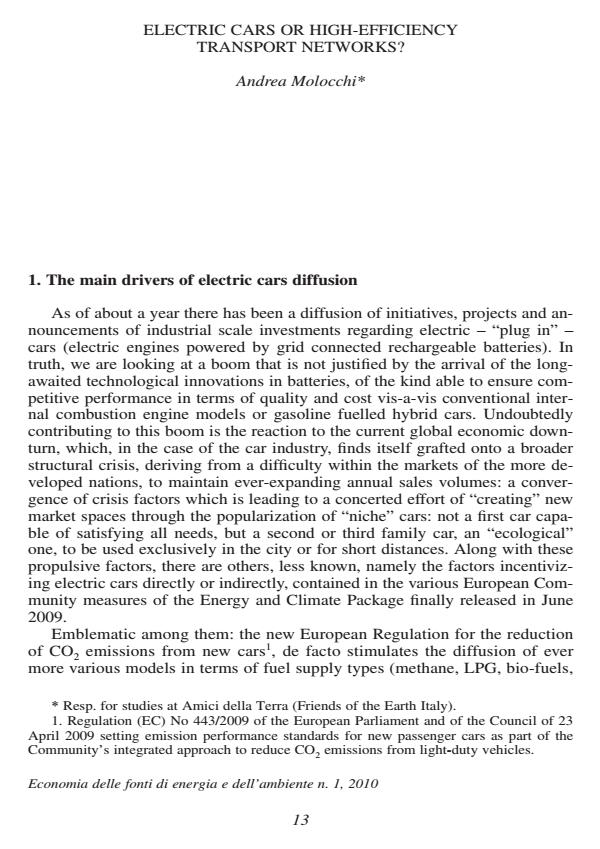Electric cars or high-efficiency transport networks?
Journal title ECONOMIA DELLE FONTI DI ENERGIA E DELL’AMBIENTE
Author/s Andrea Molocchi
Publishing Year 2010 Issue 2010/1 Language English
Pages 17 P. 13-29 File size 2069 KB
DOI 10.3280/EFE2010-001002
DOI is like a bar code for intellectual property: to have more infomation
click here
Below, you can see the article first page
If you want to buy this article in PDF format, you can do it, following the instructions to buy download credits

FrancoAngeli is member of Publishers International Linking Association, Inc (PILA), a not-for-profit association which run the CrossRef service enabling links to and from online scholarly content.
The main drivers of the electric cars diffusion which is projected in the next decade are to be seen in the industry effort to create new spaces in mature car markets (supply side), and in demand side effects of current climate mitigation policies in the transport sector, focused on CO2 emissions and energy efficiency of new vehicles sold. Indeed the energy performances of electric vehicles are projected to be highly variable; the final results of fleet average comparisons with internal combustion engines vehicles will be affected by at least: a) the real energy efficiency of the EV models (in particu- lar by their weight), b) the battery efficiency rate; c) the average energy losses of the national grids, and d) the national thermoelectric generation efficiency. For example, if sensitivity analysis on Germany or USA power plants efficiencies is undergone, EV primary energy consumptions result to be respectively +8% and +30% higher than conventional ICE cars. Moreover, EV credentials in terms of transport external costs reduction are very poor, particularly for congestion. If we look at research results comparing the external costs of different transport modes, high net benefits may be alternatively seen in public transport and rail based mobility (and also in short sea shipping for certain freight transport types) either in terms of energy efficiency and external costs reduction. An EU27 wide transport indicator based analysis is provided in chapter 4 to better highlight this "structural" additional driver of transport external costs, which has strictly little to do with vehicle level efficiency, rather it represents an efficiency in urban planning and infrastructural planning: a "system" efficiency in providing availability and access to highly energy efficient transport modes and services. In the final chapter recommendations for transport and energy European policies are provided, starting from a target setting based on external costs indicators (capturing also and not exclusively the energy efficiency and savings potential offered by transport infrastructures and vehicles), followed by an urgently needed Long term Action plan for railways networks and intermodality development. As to EVs, it is recommended to regulate them under an extension of the current EU CO2/km average target approach, by setting a common (final) energy consumption efficiency standard for all car innovations. Public funds collected from external costs road charging may be better concentrated by EU and Member States on this infrastructural Action Plan rather than on urban electricity grids for EVs.
Keywords: Transport, electric car, energy policy, externalities
Jel codes: Q51, R40, L92
- Barriers to the adoption of electric cars and electric motorcycles in Vietnam Nhi Truong, Gregory Trencher, Masaru Yarime, Brendan Barrett, Kazuyo Matsubae, in Transportation Research Part D: Transport and Environment 104204/2024 pp.104204
DOI: 10.1016/j.trd.2024.104204
Andrea Molocchi, Electric cars or high-efficiency transport networks? in "ECONOMIA DELLE FONTI DI ENERGIA E DELL’AMBIENTE" 1/2010, pp 13-29, DOI: 10.3280/EFE2010-001002